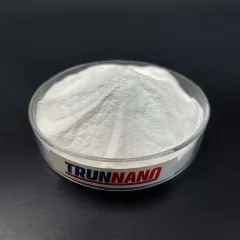Overview of nanoparticles:
Nanopowder, also known as nanoparticles, generally refers to ultrafine particles with a size between 1-100nm. Some people call it ultrafine particles. Its size is larger than atomic clusters and smaller than ordinary particles. Based on its size calculations, assuming each atom is 1 angstrom in size, it contains between 100 and 1 billion atoms. Nanoparticles are smaller than normal biological cells and about the size of viruses. The shapes of nanoparticles are spherical, plate-like, rod-like, trumpet-like, sponge-like, etc. Nanoparticles can be composed of metals, oxides, or various other compounds.
Applications of Nanoparticles:
Nanoparticles are widely used to improve the environment. For example, photocatalytic copper oxide tungsten nanoparticles are being tested to break down petroleum into biodegradable compounds. The nanoparticles are placed in a grid that provides a high surface area for the reaction. Nanotechnology is being used by many manufacturers to develop products that perform better or reduce production costs.

Nanoparticle Supplier:
We provide high-purity silicon nanoparticles, iron nanoparticles, copper nanoparticles, cobalt nanoparticles, tungsten nanoparticles, silica nanoparticles, zirconia nanoparticles, alumina nanoparticles and other ultrafine materials. Email us or click the desired product to send an inquiry.
Payment Term:
T/T, Credit Card, Western Union, Paypal etc.
Term for delivery:
By air, courier or by sea according to the needs of the customer.
Conditions of storage:
1.) Maintain a dry area at the temperature of room.
2.) Avoid high and damp temperatures.
3.) Utilize immediately following the opening of the bag inside.

FAQ:
Q1:
What are the characteristics of nanoparticles?
Re:Volume effect: Due to the small size of nanoparticles, their specific surface area is significantly increased, so their adsorption, dispersion, and optical properties have changed considerably. This characteristic makes the nanoparticles show higher activity in the chemical reaction, which can better catalyze the chemical reaction and improve the reaction rate.
Surface effect: The surface atoms, ions, and atomic groups of nanoparticles have higher energy and are easy to react chemically with the surrounding environment, thus making the nanoparticles show more active chemical properties.
Quantum size effect: When the size of the nanoparticle is equal to or smaller than the optical wave wavelength, de Broglie wavelength, the coherence length or transmission depth of the superconducting state and other physical characteristics, the periodic boundary conditions of the crystal will be destroyed, and the atomic density near the surface layer of the amorphous nanoparticle will decrease, resulting in new physical properties of the acoustic, optical, electrical, magnetic, thermal and mechanical properties. This is the quantum size effect of nanoparticles. For example, the quantum binding of semiconductor nanoparticles and surface plasmon resonance of some metal nanoparticles are discussed.
Macroscopic quantum tunneling refers to the ability of microscopic particles to penetrate the barrier, which is another essential property of nanoparticles.
Q2:
What are the applications of nanoparticles?
Re:Tissue engineering: Nanotechnology can be used to create scaffolds and structures that mimic the natural environment of cells and tissues, promoting their growth and regeneration. For example, nanofibers and nanoparticles could be used to create artificial blood vessels or repair damaged tissue.
Disease detection: Nanoparticles can be designed to bind to specific biomolecules, such as proteins or DNA, that can indicate disease. For example, nanoparticles can be used to detect cancer biomarkers in blood samples, allowing for earlier and more accurate diagnosis.
Drug delivery and treatment: Nanoparticles can be used as drug carriers to deliver drugs directly to the lesion site, improving drug efficacy and reducing side effects. For example, under the action of an external magnetic field, drug-carrying magnetic nanoparticles can deliver drugs to the diseased site through the magnetic navigation of nanoparticles to achieve targeted treatment. In addition, nanoparticles can be used in treatments such as hyperthermia.
Environmental protection: Nanoparticles can be used for pollutant treatment and environmental remediation. For example, magnetic nanoparticles can be used to separate and remove heavy metal ions and organic pollutants from water.
Q3:
What are the applications of nanoparticles in environmental protection?
Re:Water treatment: Nanoparticles have a wide range of applications in water treatment. For example, nanoparticles can be used in technologies such as nanofiltration, reverse osmosis, and dip adsorption, which can effectively filter and remove impurities, such as heavy metals, bacteria, viruses, etc., from water. In addition, nano-adsorption materials, such as Al2O3, TiO2, Fe3O4, etc., have incredibly high adsorption capacity and can quickly adsorb heavy metal ions in water, thereby improving water quality.
Waste gas treatment: Nanoparticles can also be used for waste gas treatment. Compared with traditional chemical treatment methods, nanoparticles can reduce the generation of secondary pollution.
Indoor air purification: nanoparticles can decompose harmful substances such as formaldehyde and toluene in paint and wood, especially under the action of ultraviolet light, which can adsorb and remove these pollutants more effectively, thereby improving indoor air quality.
Environmentally friendly building materials: Nanotechnology can also be applied to environmentally friendly building materials. For example, nano-functional fibers and disinfectants can be used for deodorization and antibacterial, and nano-adsorption technology can treat rubber plastic materials, remove impurities and foreign bodies, and enable recycling of waste.
Q4:
What are the application prospects of nanoparticles?
Re:Medical field: Nanoparticles have great application potential in the medical field. For example, nanomedicine delivery systems can deliver drugs directly to the diseased site, improving drug efficacy and reducing side effects.
In addition, nanoparticles can also be used for disease diagnosis and treatment. For example, nano biosensors can be used to detect biomarkers, and nanoparticles can be used as imaging agents to enhance the contrast of medical imaging technology.
Environmental protection: Nanoparticles also have critical applications in the field of environmental protection. For example, nano-adsorbent materials can be used in water treatment, air purification, and soil remediation to remove harmful substances efficiently. In addition, nanoparticles can also be used for environmental monitoring and pollution detection, providing strong support for environmental protection work.
Energy field: The application prospect of nanoparticles in the field of energy is also very broad. For example, nanomaterials can be used in solar cells, fuel cells, and energy storage materials to improve energy conversion efficiency and reduce energy consumption. In addition, nanoparticles can also be used in the development and utilization of hydrogen energy, contributing to the development of clean energy in the future.
Information technology: Nanoparticles also have critical applications in the field of information technology. For example, nano-electronic devices have the characteristics of ultra-high speed, ultra-capacity, ultra-micro, and low energy consumption. They are expected to replace conventional semiconductor devices entirely in the future. In addition, nanoparticles can also be used to make high-tech products such as nanosensors and nanocomputers.
Q5:
What are the advantages of nanoparticles?
Re:Small size, large specific surface area: the size of the nanoparticles is between 1-100 nm, and their specific surface area is significantly increased, making the nanoparticles have high surface activity and adsorption capacity. This characteristic makes the nanoparticles show higher activity in the chemical reaction, which can better catalyze the chemical reaction and improve the reaction rate.
Unique physical and chemical properties: Due to the size and surface effects of nanoparticles, they have some unique physical and chemical properties, such as quantum size effect, macroscopic quantum tunneling effect, etc. These characteristics make the nanoparticles have excellent performance in optics, electricity, magnetism, etc. and provide a broad space for the application of nanomaterials.
Broad application prospects: nanoparticles have essential application prospects in many fields, such as medicine, environmental protection, energy, information technology, and so on. For example, in the field of medicine, nanoparticles can be used in drug delivery, disease diagnosis, and treatment. In the field of environmental protection, nanoparticles can be used in water treatment, air purification, and soil remediation.

